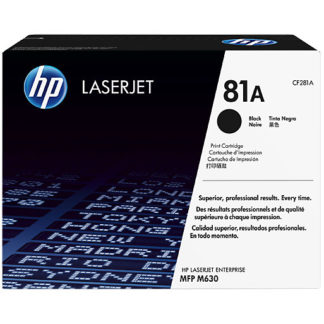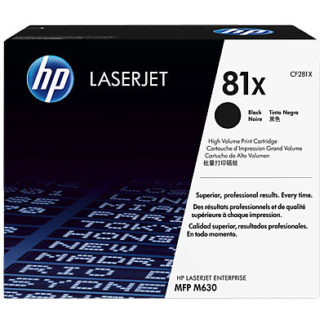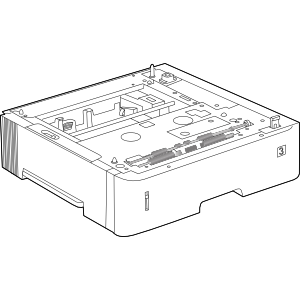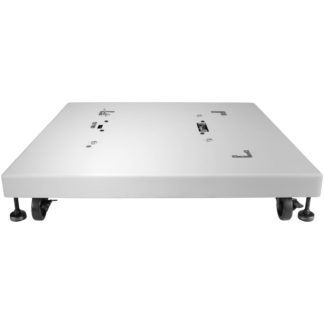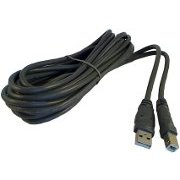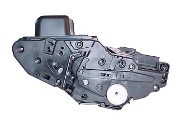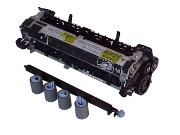We aim to provide the maximum information possible on the M604, M605 and M606
This is a long page - a bit shorter than HP's 24 page brochure (fewer footnotes, hopefully more content)
Summary writeup
HP's lowest print costs. Easy to look after.
Outline Market Position
Low running costs without expert attention
Fast | Felxible | Expandable
Specification In Brief
M604 50 pages per minute
M605 55 pages per minute
M606 62 pages per minute
X models have an extra cassette tray and graphic control panel
M604 Series Printer Lineup
-
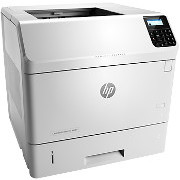
E6B67A HP Laserjet Enterprise M604n
Please email us to confirm availability
A4 Mono (B&W)
LAN, USB
5,000 - 13,000 pages/month
10,000 page cartridge
-
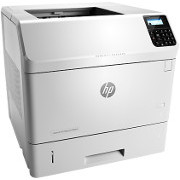
E6B68A HP Laserjet Enterprise M604dn
Please email us to confirm availability
A4 Mono (B&W)
Automatic Duplex
LAN, USB
5,000 - 13,000 pages/month
10,000 page cartridge
-
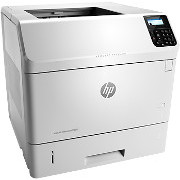
E6B69A HP Laserjet Enterprise M605n
Please email us to confirm availability
A4 Mono (B&W)
LAN, USB
5,000 - 16,000 pages/month
25,000 page cartridge
-
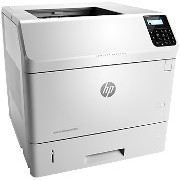
E6B70A HP Laserjet Enterprise M605dn
Please email us to confirm availability
A4 Mono (B&W)
Automatic Duplex
LAN, USB
5,000 - 16,000 pages/month
25,000 page cartridge
-
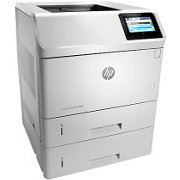
E6B71A HP Laserjet Enterprise M605x
Please email us to confirm availability
A4 Mono (B&W)
Automatic Duplex
LAN, USB
5,000 - 16,000 pages/month
25,000 page cartridge
-

E6B72A HP Laserjet Enterprise M606dn
Please email us to confirm availability
A4 Mono (B&W)
Automatic Duplex
LAN, USB
5,000 - 20,000 pages/month
25,000 page cartridge
-
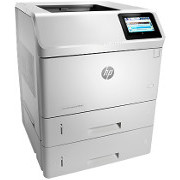
E6B73A HP Laserjet Enterprise M606x
Please email us to confirm availability
A4 Mono (B&W)
Automatic Duplex
LAN, USB
5,000 - 20,000 pages/month
25,000 page cartridge
HP Original Cartridges
Security Devices
Multifunction Equivalents
HP's LaserJet Enterprise MFP 630 series use a similar print engine to the M604 series - and the same cartridge and general principles. The fuser and the accessories are different. To accommodate the scanner the engine is turned sideways but the cassette trays still open to the front. Since MFPs have more document management options there is a rather bigger control panel as well.
-
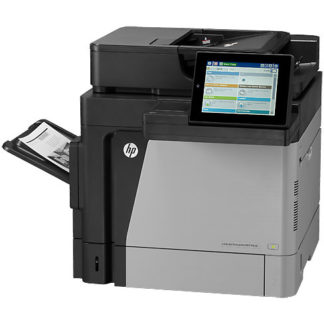
B3G84A HP Laserjet Enterprise MFP M630dn
Please email us to confirm availability
A4 Mono (B&W)
Automatic Duplex
LAN, USB
Scan/Copy
5,000 - 28,000 pages/month
25,000 page cartridge
-
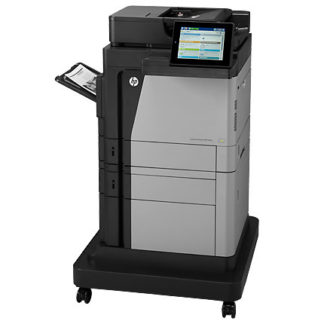
B3G85A HP Laserjet Enterprise MFP M630f
Please email us to confirm availability
A4 Mono (B&W)
Automatic Duplex
LAN, USB
Fax, Scan/Copy
5,000 - 28,000 pages/month
25,000 page cartridge
-
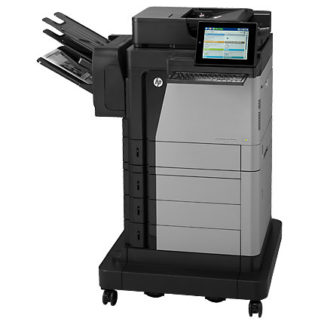
B3G86A HP Laserjet Enterprise Flow MFP M630z
Please email us to confirm availability
A4 Mono (B&W)
Automatic Duplex
LAN, USB
Fax, Scan/Copy
5,000 - 28,000 pages/month
25,000 page cartridge
Accessories
Memory & Disk
Data Cable
In an odd act of petty meanness printer manufacturers generally don't ship a data cable. their argument is probably that its an environmental measure as most people already have network cables.
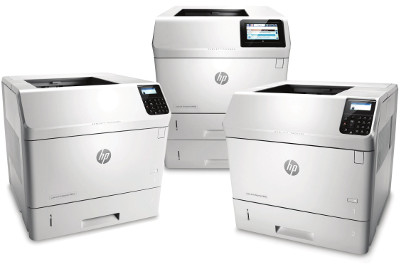
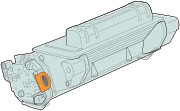
Big cartridges giving low cost print
CF281X cartridge costs about £150 - more than many printers, but it prints for 0.7p per page (and they don't)
| • High capacity print cartridges for 10,000 and 25,000 pages |
| • High speed 62 page per minute throughput |
| • Easy maintenance |
| • Flexible secure networking |
| • Energy saving |
| • HP's proven track record |
| … some of the M604 /M605 /M606 strengths. |
HP LaserJet M604, M605 & M606 Printers.
The HP LaserJet M604 series are A4 mono laser printers, they only produce black and white print. Most workplace documents are informative, not decorative, so they don't need anything else.
Launched in February 2015 the M604 series is aimed at situations where print is a continual requirement Buyers are often replacing one of this printers long line of ancestors - LaserJet 4000, 4100, 4200, 4350, P4014 or M601 and know what to expect.
Photographs will look reasonable with this kind of printer, but colour is not possible. It's a cost issue. IT professionals know that "colour for the price of black and white" is a marketing myth. The M605 and M606 will prove a lot cheaper to run than little mono printers like the P1102 or P2035 as well.
Cost of print is a key issue to a lot of people. Text and forms are the main aim of this kind of printer; correspondence and signed documents for instance. They can print a good looking newsletter or sales flyer at low cost. It is true that mono will never have the impact of colour. The problem is that people can be paying 7p or more for a colour page. The M605 and M606 printers can deliver a simple black & white page for 0.7p - a tenth the price.
Print remains a regular requirement in many professions: legal, medical, insurance and finance, billing, banking, medicine, education, labelling, picking lists, goods dispatch … - you know why you want to print. Not everyone knows the cost of printing as numbers of lesser printers suggests. These printers cost a bit more to buy and in return they give HP's lowest cost per-page. These printers could have a long life as well, their predecessors have often lasted ten years and more, and printed more than a million pages.
What these printers provide is a hard-working piece of industrial kit for the office or factory. They look good too, for a printer!

What HP Say
Keep business moving with the productive HP LaserJet Enterprise M604, M605, and M606 printer series. Tackle high-volume jobs with ease and equip workgroups for success with mobile printing options. Expand capabilities as needs change with this fast and versatile line of printers. Easily manage and safeguard your printing fleet, and help reduce costs and environmental impact.
HP JetAdvantage
Business Workflow and Printing Solutions.
Streamline crucial business processes and tasks, using powerful HP solutions for printing and imaging. With the latest workflow and productivity tools for efficient fleet management, you can reduce IT workload and costs, boost employee performance, and enable users to print safely-wherever business demands. Learn more at hp.com/go/printingsolutions.
Workgroups of 10 to 25 users printing 5,000 up to a maximum of 20,000 pages per month can share this high-performance printer. Accelerate office productivity with optional paper-handling accessories, a maximum input capacity of 3,600 sheets, and an optional HP High-Performance Secure Hard Disk. Choose the HP LaserJet Enterprise M605x and M606x printers for an intuitive colour touchscreen control panel. Keep workgroups covered-in the office and on the road-with easy mobile printing options.
HP Document 4AA5-6974EEE, February 2015.
Outline Market Position
Low running cost is crucial with these big mono printers. The big CF281X cartridges deliver HPs lowest cost per page in an office printer.
Print speed can be a key issue for people. Keeping people waiting even for a few seconds has costs that mount up. These machines are fast - not the very fastest on the market, but without sacrificing reliability.
Printers like this are noted for being reliable and easy to look after. The HP M604 series printers are a new design but have a pedigree that stretches back to the original "LaserJet" of 1984. A problem for sales of new printers is that predecessors like the LaserJet 4200 were such great machines and go on being used. :
- cartridges are the "all-in-one" design, problems are normally solved by just changing the cartridge
- components are designed for a long life
- components that might fail such as fusers and rollers are easy to replace. User changeable clip in parts.
- Internal design has a long heritage ( P4014 and M601), so HP has had the opportunity to get things right
- Long-life cartridges and the big 500 sheet tray reduce handling - a major cause of printer issues.
- Diagnostic commands in the service menus which can run individual motors and report sensor status.
Basically, should one of these go wrong the problem can usually be solved by changing the cartridge or the maintenance kit. If you have a cartridge and a kit you can be back up and running within the hour.
Key Features
- Inherits the successes of the P4014 and M601 series.
- Same low cost per page.
- Same expandability and paper handling options.
- 20% saving on energy costs thanks to low melting point toner and a cooler fuser.
- Improvements in security and management
- Wireless access capability
- Easy to use touchscreen control panel on X models
- Multifunction Scanner/Copier/Fax version is the LaserJet M630 MFC
This web-page summarizes what we know about the LaserJet M604 series. Information is drawn from several of HP's PDFs brochures, notably the 24 page version 4AA5-6974EEE, the user guide E6B67-90907 and the service manuals for the printers (no document number)and M630.
We also draw on experience of HPs models dating back to the earliest LaserJet launched in 1984 and of recent models like the P4014 and M602.
HP sales literature tends to be remorselessly positive about the product. We might look a bit more at context, history, user-base and the likely maintenance and support issues.
Furthermore these machines have the diagnostic capabilities to allow an IT department or HP contract engineers to spot problems in advance. An error log shows what is happening, component use counts suggest reasons and HP (or our) website will help solve what is going on.
We might look at some of the negatives as well. Machines designed and sold as copiers achieve even lower per-page prices, down below 0.3p per page in the case of some Samsung machines. Copier-style devices are more expensive to buy (or lease) and tend to have a larger floorspace footprint than these printers. The lowest possible running costs are achieved using separate toner, developer and drum. The disadvantage of that is complication, it may need a copier engineer skill-set to decide where a fault lies.
HP's M604 series are very comparable to the Lexmark MS810 series (and Dell's B5465). If you want a big colour control panel on a printer Lexmark still have the advantage, but that does push their purchase price up. The Lexmark has the separate toner and imaging unit they favour as well, with the toner yielding 45,000 pages. Lexmark's larger toner isn't reflected in notably lower per-page prices however.
For situations where the M604/M605/M606 are too large the M506 launched in October 2015 might prove better. It's a new smaller-footprint version of the popular LaserJet P3015 and takes cartridges not far short of those for the M604/M605. It lacks the easy to change fuser though.
HP have always dominated the high productivity mono laser printer market and we think the M604, M605 and M606 retain that edge.

Model Spec In Brief
| Model | - | Speed | First Page | Paper | Duplex | Control |
| M604n | (E6B67A) | 50 | 7.5 | cassette | optional | LCD+Keys |
| M604dn | (E6B68A) | 50 | 7.5 | cassette | duplex | LCD+Keys |
| M605n | (E6B69A) | 55 | 7.0 | cassette | optional | LCD+Keys |
| M605dn | (E6B70A) | 55 | 7.0 | cassette | duplex | LCD+Keys |
| M605x | (E6B71A) | 55 | 7.0 | dual cassette | duplex | TouchScreen |
| M606dn | (E6B72A) | 62 | 7.0 | cassette | duplex | LCD+Keys |
| M606x | (E6B73A) | 62 | 7.0 | dual cassette | duplex | TouchScreen |
Derived from HP Document 4AA5-6974EEE, February 2015.
Specification
HP's top of the range A4 laser printer for black and white print at a low cost per page.
High capacity cartridges:
- 10,500 page capacity fitting the M604, M605 or M606, giving a print cost of 1p per page
- 25,000 page capacity fitting the M605 and M606 only, giving a print cost of 0.7 p per page
User changeable maintenance kit allows most hardware problems to be solved by users.
An Embedded Web Server and diagnostic software allows remote troubleshooting.
These printers have a fairly small footprint for machines that provide a big cartridge and high speed. With a limited number of accessories they could fit on a desk but might be better on an accessory table. With more than two or three trays they should be made floor-standing with the optional printer stand.
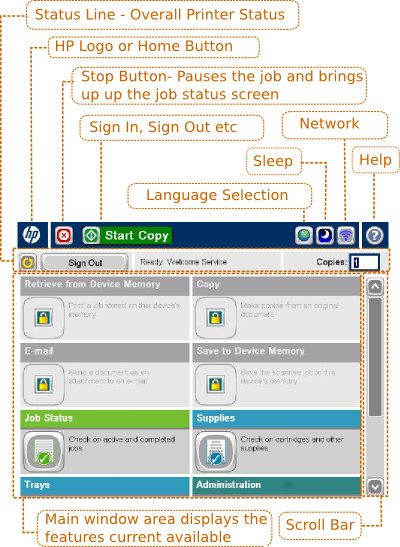
Control:
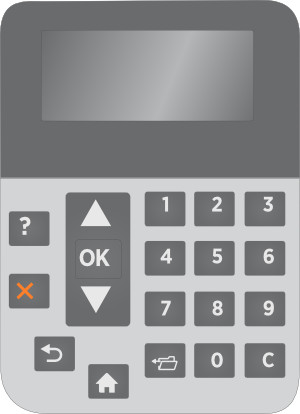
Most of the printers have the KeyPad control panel. This is a 4 line display and a 10-key numeric keypad very like that for a calculator.
Features List
|
|
The Laserjet M605x and M606x printers have a 10.9cm TouchPad very like that on a smartphone. The touchscreen is about 2x3 inches, the position is rotatable for easier use and has 480x272 resolution). Screen contents are context-sensitive. There is a single illuminated home button under the panel to easily return to the "Home" screen.
The precise display is determined by a combination of firmware, settings, and potentially the dialogue from a document management system, of course.
If a big-screen printer is your objective then the 10.2" Colour Touch Screen on Lexmark's MX810 series totally overshadow what HP are offering on the M605x and M606x. HP's M630 MFP (the "copier" version of the M605) runs it a close second with an 8 inch screen. There are clearly arguments to be had about document management systems and design philosophy. For instance, if you want a big screen separate from the PCs in the workplace might a browser on an Android tablet be a better bet than any screen built into a printer? It would be lot less proprietary.

What HP Say
Monitor jobs and settings directly at the printer using the 4-line display and 10-key pad on the n and dn models. Choose the M605x or M606x printer to equip employees to fly through tasks from an intuitive 10.9 cm colour touchscreen. Help ensure documents land in the right hands with PIN printing-available on all models.
With the FutureSmart 3.2.3 firmware the device administrator can change the Service Access Code (PIN). Applications that can be locked are: fax, copy, send-to-email, send-to-folder, save-to-sharepoint, send-to-device-memory, retrieve-from-device-memory. An advantage of changing the service PIN is that the same code can be used by all recent printers on a site. A potential disadvantage is that service engineers will need the non-standard code to complete their tasks.
HP LaserJet Enterprise (FutureSmart) Administrator configurable Service Access Code (PIN)
The printer has an Embedded Web Server. This provides comprehensive control over the printer to authorised users.

What HP Say
Advanced capabilities, easy management
Streamline fleet management while giving workgroups the tools to support larger business initiatives. Extend your print capabilities as business evolves and customise new solutions seamlessly. Safeguard data, documents, and the printer with a full suite of top-tier, embedded and optional HP JetAdvantage security features and solutions.
Print only what you need-straight to the right hands
Increase security, restore control, and help avoid additional expenses. HP JetAdvantage Private Print 20 helps prevent unauthorised access to confidential print jobs and gives users the flexibility to pick up jobs at any compatible device. For more information, visit hpjetadvantage.com.
Do more with your investment
Easily expand and update this printer as solutions advance and workgroup needs grow. HP's cost-effective solution for hardware upgrades-the Hardware Integration Pocket-allows you to integrate optional secure mobile printing or authentication solutions, such as card and badge readers. And HP's Open Extensibility Platform (OXP) creates a unified environment for software solutions that run on your HP Enterprise devices-providing sound investment protection, consistency for end users, and easier management.
Safeguard your data and devices
This HP Enterprise printer comes with more than 100 embedded settings to help safeguard your sensitive business information. Use the optional HP Imaging and Printing Security Center to apply efficient, fleet-wide security policies to protect all your HP print devices. 21
Add another layer of protection and further safeguard information in transit over the network and stored on the printer-keys, passwords, certificates and more-using the optional encrypted HP High-Performance Secure Hard Disk 5 and HP Trusted Platform Module. 22
HP Document 4AA5-6974EEE, February 2015. For more information, see Appendix B "Security features" (p21) of that document.
Security Features:
Printer manufacturers tended to rather neglect security in the past. It's fair to say that both corporate IT and the printer makers regarded the machine as a big dumb thing from which information emerged and that it was the paper that was the security problem, not the printer.

Modern printers aren't like that however. They have an operating system, a network stack, and they can host "applications" such as forms handling software. Putting a hard disk into the printer so that users can pull a document from the queue when they are present using a PIN means the disk stored a copy - so it should be encrypted and everything must be erased when the printer is decommissioned. (Arguments against putting too much intelligence in the printer don't suit print manufacturers; they prefer to sell clever gadgets).
HP are making a big sales point of print security, both on the network and on any local hard disk in the printer. The printers offer Kerberos, LDAP and 802.1X authentication, HP and 3rd party ID and badge readers via the "Hardware Integration Pocket" (HIP), An access control list and a firewall and USB disablement for instance. (The M604 shouldn't be like those P4014 printers exposing themselves all over the Internet).
Paper itself is always a security issue; it is much easier for people to see something they shouldn't on a page than on a network. Companies often leave important documents lying around on the printer. PIN printing improves things, the user requesting the print is present at the point it prints. Banks, finance and medical records ought to be kept secure so the security advances in the M604 series printers will be of interest.
In line with this theme all the printers have either:
- A numeric pad to enter PIN codes and suchlike (The M601 missed it out)
- Or a touchscreen on the "X" versions.
HP's older printers would upload firmware from any port at any time - flexible but insecure. Security issues should be a thing of the past - signed firmware closes off one source of danger.
Duty Cycle:
| M604 | M605 | M606 | |
| Recommended Monthly Page Volume | 5,000 pages to as high as 13,000 pages | 5,000 pages to as high as 16,000 pages | 5,000 pages to as high as 20,000 pages |
| Duty Cycle | Up to 175,000 pages (A4/letter) | Up to 225,000 pages (A4/letter) | Up to 275,000 pages (A4/letter) |
The Recommended Monthly Page Volume (RMPV) is a guide to the sort of office that needs a printer like this. Its aimed at workgroups of 10 or more that use print frequently - ( We think these machines can save money and hassle at lower print volumes).
If you buy more than two boxes of paper (a box is 5 reams, i.e. 2,500 sheets) per month then you are the "target audience". We might argue that if you value low running costs and reliability then you could consider one of these machines with consumption of a box per month.
"Duty Cycle" is a term that has been round in the print industry for a long while. Taken as a surrogate for robustness it has been exaggerated beyond any sensible meaning - but once a game is established manufacturers can't easily drop out.
Duty Cycle is more a matter of warranty cover than any practical engineering difference. Print path components and build quality are the same in all models; HP will allow 275,000 pages per month through an M606. It is worth pointing out that at 225,000 pages per month that would be 11 cartridges and a maintenance kit each month at something like £1300 - possibly better to get an even bigger printer then?

Copier Abilities:
HP's multifunction equivalent to the M604 series is the M630 MFP - or to give its (excessively) full title the "HP LaserJet Enterprise 600 MFP M630". This has a copy speed of 60 copies per minute to match the printer and an 8 inch touchscreen.
The scanner on the M630 has a 100 sheet ADF, with a scan speed of 62 ppm A4 and 86 images per minute A4 duplex - and embedded OCR.
The LaserJet M630 is available in a desk standing version from just under £1,500 (at April 2015) ranging to a floor-standing machine with four trays and an output stacker with hard disk and Fax at just over £3,000.
Usefully, the LaserJet M630 is a closely related engine and takes the same cartridges as the M604 series - although they look rather different. You can have a floorstanding machine for postroom functions, and printers amongst the desks sharing consumables, parts (but not the fuser unit or trays) and working principles.

What HP Say
This HP LaserJet device prints with impressive speed-starting at up to 50 ppm, A4 with the M604 series, and accelerating to 55 ppm, A4 with the M605 and 62 ppm, A4 with the M606 series. Large print jobs are completed quickly, while still maintaining consistently great looking black-and-white output. Choose HP ImageREt 3600 for speedy day-to-day printing or HP ProRes 1200 for true 1200 by 1200 dpi where fine lines and details are critical to your job.
HP Document 4AA5-6974EEE, February 2015.
Print Speed:
These are HP's fastest office printers with the M606 delivering 62 pages per minute on A4 paper (65 pages per minute on US letter).
There are faster printers around. An example is the Lexmark MS810 series - a good match for the M604 in terms of feature set and has similar expansion capabilities. Dell's B5465dnf is another example (resembling the Lexmark). HP's pagewidth inkjets such as the OfficeJet Pro X and Brother's HL-S7000DN series equal or outpace this machine, as do the MemJet/Lomond inkjets.
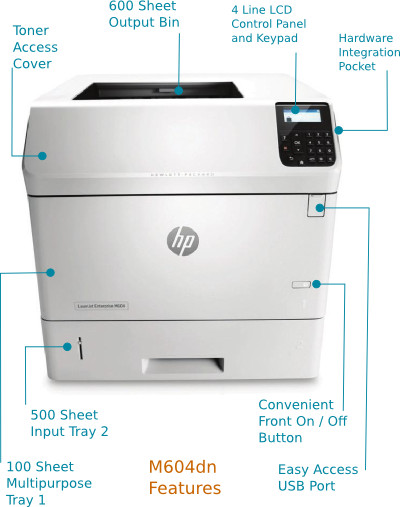
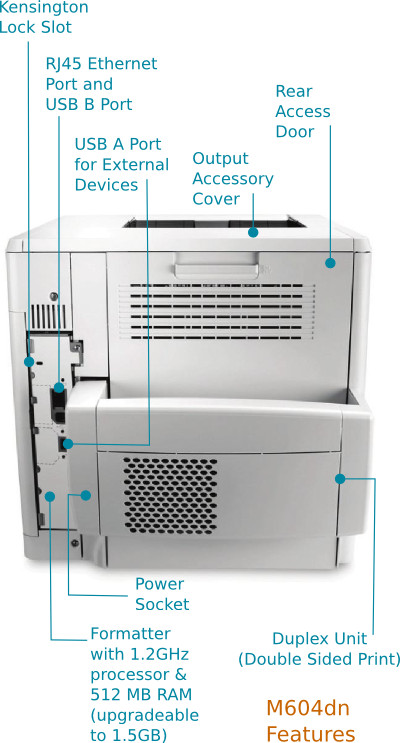
So what is to like about HP's offering? "Established technology from the print industry's leading vendor" in a phrase.
Office managers have yet to be convinced that pagewidth inkjets with more than 5000 nozzles will prove more reliable than ordinary inkjets with a thousand or so; there is no self-evident reason (although the cleaning stations in the pagewidth printers are more advanced). Laser printers are trusted technology.
Amongst the things that keep customers loyal to HP or Lexmark are things like stocking cartridges, cartridge change and fault identification procedures, fleet management software and increasingly the approach to document management.
Print speed specification used to be crucial. With most office quality printers being quite fast anyway the actual specification may be diminishing in importance.
- M604 - 50 ppm A4 (52 ppm letter). Duplex up to 33 images per minute (35 ipm letter)
- M605 - 55 ppm A4 (58 ppm letter). Duplex up to 36 images per minute (38 ipm letter)
- M606 - 62 ppm A4 (65 ppm letter). Duplex up to 41 images per minute (43 ipm letter)
As usual with HP's top of the range office printers the actual print speed is determined by firmware. You pay more for the M606 and they provide a faster printer.
Double sided printing (duplexing) drops print speeds dramatically in most office printers. Turning the page around in the duplex unit takes time. A printer capable of 62 pages per minute drops to 41 images (sides) per minute.
Fast First Page
For single pages and short runs the crucial thing is not the raw print speed but the warm-up time to first page out. HP instant-on fusers cut that to 7 seconds for the M605 and M606 and just half a second longer with the slightly slower M604.
Print Resolution:
These printers offer a choice of two resolutions:
- HP ImageREt 3600 (600 x 600 dpi) for normal use
- ProRes 1200 (1200 x 1200 dpi) - for best quality reproduction and fine lines.
Some printers have dropped 300dpi resolution. Perhaps it doesn't show modern optics and toners off to best effect and the savings in data buffers on PCs and over modern networks possibly mean it just isn't worth having.
Reviews of the P4014, M601 and M604 are usually a bit critical of text print quality. For instance, Tony Hoffman writing in PC-Mag says of an M605X he reviewed:

In my testing, the M605X's overall output quality was average for a monochrome laser, with slightly subpar text quality, average graphics quality, and slightly above-par photos. Fortunately, even slightly subpar text quality is still good enough for most business uses except those requiring very small fonts.
With graphics, the M605x did well at resolving what, in the original art, were very thin colored lines. In several test pages, it had trouble differentiating between zones of similar tone, and in one test illustration meant to show a gradation from dark to light and back to dark, there was very little difference in tone. Most people would consider the graphics quality good enough for PowerPoint handouts.
Not a glowing testament but good enough. To be honest we hadn't really noticed a problem with our printers. There are few reasons to choose a black and white laser printer for photographic work so there is no great competition to offer especially high resolution figures. If photographs are all important, choose an inkjet.
Paper Handling:
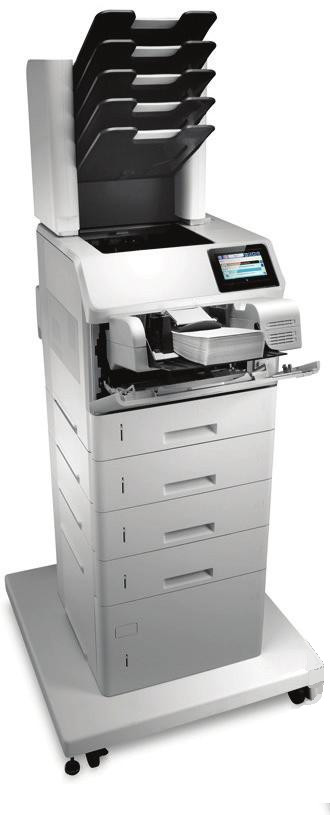
The HP LaserJet Enterprise M604, M605 and M606 are all designed around fast handling of standard office papers, "letter" sized in North America and ISO "A4" in most of the rest of the world.
What HP offers is very similar to the Lexmark MS810 series. The surprising omission at the moment is a scanner to match. A multifunction version of this printer is available as the M630. Lexmark also offer a separate but dedicated scanner
All printers have:
| MP-Tray | drop-down 100 page multipurpose tray (MP-tray) |
| Tray 2 | drawer-like 500 page slide in cassette |
| Output Tray | 600 page face down output tray recess on top of the printer |
Input Options Are
| Duplex Unit F2G69A | The "DN" models (M604dn, M605dn, M606dn) and the "X" models (M605x, M606x) include a duplex unit - they can print double sided automatically. The duplexer is available for other models, part F2G69A |  |
| 500 Sheet Feeder F2G68A | Models M605x and M606x come with an extra 500 sheet feeder tray (or optional input accessory as HP call it). The printer sits on top of this. |  |
| Further Sheet Feeders | A maximum of 4 F2G68Atrays can be used. There is one MP tray and a cassette built in and there can be up to 4 extra sheet feeders. One of these can be the 1500 sheet feeder F2G73A. With more than 3 trays the LaserJet Printer Stand F2G70Ais needed for stability. | |
| 1500 Sheet Feeder F2G73A | One 1500 sheet front-loading high capacity feeder F2G73Acan be used at the base of the stack. The high capacity feeder allows the printer to run for a longer period without attention. |  |
| Envelope Feeder F2G74A | For feeding up to 75 envelopes the special feeder accessory F2G74Aplugs into the front of the machine above the MP tray. |  |
Output Options Are
| Multiple Mailbox F2G81A | A Multiple Mailbox provides 5 delivery slots on top of the machine, part F2G81A. | 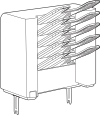 |
| Stacker F2G71A | An offset stacker positions successive sheets of a long print job so they can be distinguished, the part is F2G71A |  |
| Stapler Stacker F2G72A | A stapler stackerF2G72Acan put a staple in the corner of each job. |  |

What HP Say
Think about work, not reloading paper
Meet high volume demands, effortlessly. Automatic two-sided printing options and versatile paper tray options-giving users up to 3,600-sheet maximum input capacity 4 -mean fewer trips to reload and more time for business. 13
Customise your printer and get just the features you need
In addition to the standard printer features, add any of the following optional features to any model and get the device that fits your office:
- Automatic two-sided printing (standard on x and dn models)
- A custom media cassette to add support for more paper sizes and types 3
- Additional paper input trays and optional stand for a maximum of 3,600 pages 4
- Finishing options like a 500-sheet stacker, a 500-sheet stapler/stacker, or a 500-sheet, 5-bin mailbox 3
- 1 GB additional memory for a total of 1.5 GB
- 2 internal USB ports
- HP Jetdirect 3000w NFC/wireless direct accessory 7,8 (standard on x models)
- Wireless networking 14
- Encrypted HP High-Performance Secure Hard Disk 5
Get back to work quickly
Improve workgroup efficiency. Have jobs pre-sorted and stapled, print on a variety of media sizes, and make business mailing simple and professional with additional paper-handling accessories. 3
HP Document 4AA5-6974EEE, February 2015.
Other Options
| Printer Stand F2G70A | If more than 3 trays are used the printer-stand is needed. It makes the printer floor-standing for accessibility and provides some extra width at the base to make the stack stable. The floorstand is part F2G70A. |  |
| Custom Media Tray F2G75A | There is also a "Custom Media Tray" for printing unusually small media such as index cards and labels. It slides into the space otherwise occupied by tray 2. Look for F2G75A. |  |
| There are also a number of internal hardware and software options which are not directly relevant here. |
Maximum input from all media sources combined is 3,600 pages.
Paper Weights and Media Types
Tray 1, the fold down "MP-tray" gives a relatively smooth "C" shaped path through the machine and can handle media weights from 60 to 200 gsm (bank paper to card). Heavier card may feed best to the rear drop-down tray - remove the duplexer if there is one.
Tray 2, the cassette in the base of the printer and other trays below it have a more or less "S" shaped paper path, they can handle media weights from 60 to 120 gsm (bank paper to light card).
HP paper is available. Using special paper might be wise with inkjets where there is a reaction between the ink and the paper coating. Laser printers don't need special paper - any ordinary well treated office paper that is within specification should suffice. If paper curls after printing that is a sign it is too damp. Persistent misfeeds (Error 13) with paper that works elsewhere could be worn out pickup rollers.
Some special media like transparencies and card change printer behaviour. Setting the computer to print on card or heavy media will increase the fuser temperature - if you then use ordinary office paper you may get "offsetting" - ghosting from text just printed elsewhere on the page. Setting the computer to print transparency may make the printer run with a cool fuser and more slowly. Make sure the computer print settings are correct for the job you are doing.
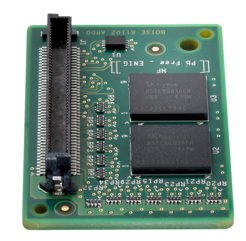
Processor:
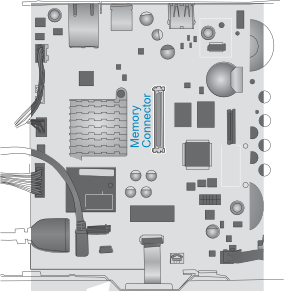
The processor is a 1.2 GHz device.
We haven't yet found a statement as to which processor is used, it will almost certainly be a PMC Sierra MIPS embedded type, as all its predecessors back to the LJ-4000 have been. Just out of interest it is three times the clock speed of the processor in the P4015, introduced in 2008. The finger of history points to it running LynxOS as well, if that is of any interest.
Memory:
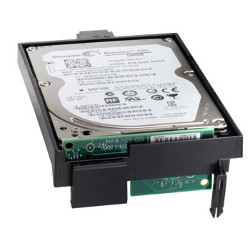
RAM Memory is 512MB as standard. For most purposes this will be enough - few people needed to expand the 128MB provided on the P4015.
Memory is expandable to 1.5 GB through a single module in one 90-pin SDRAM "slot" or header. The expansion RAM is G6W84A.
Storage is a 4 GB non-volatile storage; Firmware encryption (AES 128 or AES 256) of customer/job data; Secure Cryptographic Erase - Job Data, Secure Erase - Disk)
An optional memory devices is the HP High-Performance Secure Hard Disk, which gives a minimum 500 GB storage. If you intend to make extensive use of PIN released private print jobs then this is probably required. Part number is B5L29A. Details seems to be:AES 256 hardware encryption or greater; Secure erase capabilities (Secure File Erase - Temporary Job Files, Secure Erase - Job Data, Secure ATA Erase - Disk)

What HP Say
Meet business needs in the office and beyond
Business is mobile, and so is your workforce. Keep them covered-at their desk, on the way to the office, or stepping off a plane for an important meeting - with easy printing options from mobile devices. 1
Print without wires from mobile devices
Enable wireless direct printing from virtually anywhere in the office from smartphones, tablets, and notebook PCs. 8 Or, walk up and print with a touch of your NFC-enabled smartphone or tablet to this printer. 7 (On AndroidTM devices, NFC touch-to-print is enabled via the HP ePrint app.) The HP LaserJet Enterprise M605x and M606x come with these features built-in, but every model can add them via an optional accessory.
There's no need to search through a long list of devices-automatically discover the nearest printer without accessing your corporate network. Security and user access settings-like encryption and a configurable passphrase-can be easily set up with HP Web Jetadmin 15 or the HP Embedded Web Server.
Print from a wide range of mobile devices
Easily print documents, emails, PDFs, and more from iPhones® and iPads® as well as smartphones and tablets running iOS, Android, Windows® 8, and GoogleTM ChromeTM operating systems-generally no setup or apps required. 1 Simply open and preview the content you want to print, select your printer, and hit Print. For mobile devices without built-in print support, users will first need to download the HP ePrint app or HP ePrint software. 19
Enable mobile printing- anytime, anywhere
Even when employees are travelling, a printer can always be close at hand-with HP ePrint 19 and more than 30,000 HP Public Print Locations. Empower them to print virtually anywhere from a smartphone, tablet, or notebook. 1
HP JetAdvantage Mobile Print Solutions
Choose the HP mobile print solution that fits your business needs.
Wi-Fi mobile printing
Simple options for employees to print from their mobile device
- Print via the wireless network
- Or use wireless direct or NFC touch-to print for a secure peer-to-peer connection
- Generally no apps to download
- Supported on new and existing HP devices
HP ePrint Enterprise
HP's enterprise solution for secure mobile printing within the firewall- Advanced management and tracking
- Seamless integration with other solutions
- Print via app, email, or native print path
- Multi-vendor device support
HP Document 4AA5-6974EEE, February 2015.
Summarising HPs rather large number of footnotes the text above refers to: Wireless direct printing is standard on the HP LaserJet Enterprise M605x and M606x only, all other models need the HP Jetdirect 3000w near field communications (NFC)/Wireless Accessory. An Internet connection, App or software and HP ePrint account registration may also be required. Mobile devices need to be connected directly to the Wi-Fi signal of a wireless direct-capable printer prior to printing.
Interface:
The rear of the printer provides a USB 2.0 "B" type connector for direct connection to a PC (HP do not ship a data cable). The advantage of direct connection is that it will work without network settings such as TCP/IP addresses. Disadvantages include limited range of 5 metres and difficulty sharing the printer. Whilst it is possible to share a USB connected printer using the share facility in Microsoft Windows that does require the sharing computer to be turned on, and traffic passing through it will slow it down. It will generally be better to use the network interface.
There is an external "A" type plug for connecting flash-drives and pens just below the control panel. Another is located in the rear on the formatter metalwork. These can be disabled if needed, or enabled only with authentication by a PIN.

Two extra USB "A" interfaces can be provided internally using the optional USB interface B5L28A. This typically allows forms or document management software to be built into the printer, or use of devices in the Hardware Integration Pocket or "HIP".
Network:
In hardware terms there is one Gigabit Ethernet 10/100/1000T network port. Fast and Gigabit links support 802.3az Energy-Efficient Ethernet.
Support for IPsec.
802.11b/g/n wireless networking is to be available in Autumn 2015. Note that there are quite a few footnotes. One says "Wireless operations are compatible with 2.4 GHz routers only". Another says "may require purchase of an optional accessory".
WiFi printing has been commonplace on little home inkjets for some time. That has not been the case with bigger printers that handle more traffic, some of it business-critical and where the IT department will have to sort out connection issues. There clearly is a demand for it on larger printers, particularly in the executive and marketing offices that will probably want the "x" models of the machine with the bigger control panel.
It's nice to have the option of a wireless accessory. After all, these printers aren't exactly portable. Please Be Aware that this is a short note that some of the printers have some Wireless, Android and Apple IOS capability - for all the caveats see HP's brochures. Where printers are part of a businesses critical infrastructure the solidity of cable might be preferred.
Network Protocols
The usual IPv4 / IPv6 protocols are provided.
- IPv6: DHCPv6, MLDv1, ICMPv6
- IPv4: Auto-IP, SLP, Telnet, IGMPv2, BOOTP/DHCP, WINS, IP Direct Mode, WS Print
- Print-Server: Port 9100, LPD, IPP, Secure-IPP,
- Transfer: HTTP, HTTPS, FTP,
- Discovery and Configuration: TFTP Apple Bonjour Compatible (Mac OS 10.2.4 and later), WS Discovery
- Managagement: SNMPv1/v2c/v3, IPsec/Firewall
- Others: NetWare NDS, Bindery, NDPS, iPrint
Print Languages:
HP PCL 6, HP PCL 5e, HP postscript level 3 emulation, native PDF printing (v 1.7)
In the technical details, brochures also say: "HP FutureSmart Firmware, Open Extensibility Platform, easy-access USB (supported file formats: PDF, PS, Print Ready files (.prn, .pcl, .cht)) "
System-Compatibility:
As usual with HP there is driver support for most Windows operating systems, explicitly from Windows XP SP3 32 bit through to Windows 10 in all 32 bit and 64 bit editions (excluding RT OS for Tablets)
For Mac OS Print drivers are available from hp.com and the Apple Store for OS X 10.7 Lion, OS X 10.8 Mountain Lion, OS X 10.9 Mavericks, OS X 10.10 Yosemite. and for Apple's Mobile OS iOS.
There are also drivers for Android.
The HPLIP drivers are available for Linux.
See HP's full list

What HP Say
Reduce your impact- recycle HP cartridges
HP helps you recycle your Original HP cartridges-it's easy and convenient with the HP Planet Partners programme, available in more than 50 countries and territories around the world. 25 No Original HP cartridges returned through HP Planet Partners are ever sent to a landfill. For more information, visit hp.com/recycle.
HP M604 series brochure (Doc 4AA5-6974EEE), February 2015.
Environment:
Big mono laser printers like the M605 are one of the most environmentally friendly ways to print. This kind of machine can last ten years or more, unlike many small printers and completely unlike small-office inkjets.
We have little hesitation in saying printers like this have much less environmental impact than smaller printers. Big machines use fewer cartridges and those cartridges deliver much more print per kilo of weight. Quite simply, the big machines are less wasteful.
Big printers might seem to be monsters, spewing out paper and chewing up forests. In practice this kind of machine is bought to do serious work by people who have thought about operating costs and alternative ways of doing things. Those contracts, agendas, drafts, reports, despatch notes, legal documents and labels are not printed on a whim but because people still need paper to work. In the US the average person prints 10,000 sheets a year and in the UK its 8,500 sheets. A well designed, robust, cheap to run, easy to repair machine like this generally works through its tasks without fuss and waste.
One Piece versus Two or Three
HP uses an all-in-one cartridge with toner, developer and drum wrapped in a single item, almost all their printers are like this. The simplicity of a single cartridge is the argument in favour; one thing to stock and if there is an issue fault finding is a simple user action, try changing the cartridge.
Lexmark and Brother often use separate toner and imaging units. This might reduce costs and be better environmentally because the imaging unit can last two or three times longer than the toner. Cartridges for those machines aren't necessarily cheaper, however. A problem with separate parts is that there are two things to keep in stock - and when a problem develops, deciding which is the cause.
We quite often get calls from people who don't know whether their printer is inkjet, laser or other - it's a common experience in support work. Deciding whether a problem is toner, developer or drum is naturally a challenge - and messy. Of course the printer can warn that it needs a new drum but to do this before there is a likelihood of trouble it has to do so early - partly removing the environmental benefit.
A significant problem with printers is that they are scrapped when there is a problem. If fault diagnosis is difficult that is more likely. The LaserJet M604, M605 and M606 are user maintainable with a potential life exceeding ten years.
Getting the best from a printer is an environmental plus.
Mono print can be an environmental benefit compared with colour. Brochures lose part of their attraction without colour but text benefits from high contrast and perhaps documents that have to work in mono are better designed. (There are a lot of hideous toner wasting forms that might look great on a screen). Mono print certainly discourages holiday snap printing.
In the UK we recycle 80% of office paper. Recycling is easier with simple black toner and less paper cover. Colour can be highly productive sometimes. Using a mono brochure when competitors have colour would need some thought. For general use, colour is wasteful - both in financial and environmental terms.
HP have used all-in-one cartridges for this printer (as for its predecessors). A single piece cartridge has toner, developer and drum wrapped into a single consumable. This has lead to environmental arguments. Drum and developer have life in them when the toner is exhausted. The argument in favour of single-piece designs is simplicity. Experience suggests it is much easier for users to deal with one thing than separate toner and drum or even toner-developer drum devices. Single piece cartridges cause fewer tech support calls.
For these big printers, cartridges come in a choice of 10,000 and 25,000 pages. The big CF281X cartridges may seem expensive at £150 in the UK (more than the price of some printers) but the cost of print is just 0.7p per page. The environmental benefit is that printing (say) half a million pages will use just 20 cartridges and make 10 kilos of waste. Taking HP's cute P1102 as an example it would use over 300 little CE285A cartridges to print half a million pages and make 150 over kilos of waste. The build quality of little printers means they wouldn't finish the job.
HP's aim is clearly a high build quality. It is difficult to assess achievement until a few years have elapsed as a couple of bad points can be a model's undoing. These printers have a long heritage as noted before; HP have ironed out issues like the swing-plate assembly and the P4014's wobbly firmware.
A big plus for these printers is that the fuser has also been made into a cartridge. All the parts that are likely to wear out can be bought as a maintenance kit and are user changeable, with HP actively promoting the idea (some brands lock users out using secret reset codes). Because maintenance kits can be fitted easily more of these printers will run towards their million page plus capability (and fewer go for scrap).
Few if any printers perform very well in terms of a circular economy. HP's big office printers are not currently designed for such a thing, but by sheer weight of number may be amongst the best.
A circular economy manufactures things with an eye for recycling them so far as possible, then recovers the materials and makes something else. Performing well in these terms would mean the cartridges and printer parts could be re-used, interchanged then recycled.
- LaserJet M604 cartridges can do moderately well on this point. HP have made the CF281 cartridges fairly easy to refill or remanufacture. HP themselves apparently don't re-use plastic components but do use recycled cartridges as plastic feedstock.
- HP don't say they refurbish fusers although other sources have suggested they do. HP has access to the original components for cartridges and fusers; others refurbishing fusers can only hope their parts "meet or exceed" brandname parts.
Printers are full of proprietary parts. Paper cassettes, fusers and control panels that are quite meaninglessly different from other models in the same brand and from competitors. Actually these printers aren't too bad on that score. Internally most of the parts are similar to the M601 series. The skill-set for repair is the same, even if some of the part codes differ.
HP scores well on some points despite themselves. They probably don't want cartridges recycling by anyone but themselves but accept it will happen and haven't made it specially difficult. They probably don't want printers to last twenty years - selling a new one in five would be nice. Corporates will replace them under a leasing or print management contract every few years anyway, the rest of the market may try to extract a decade or more from a printer if they want.
Reservations
We said "little hesitation" about the M604 series environmental credentials. Points of hesitation are:
M604 buyers deny themselves use of the big cartridges. Buyers of the M604 get a discount priced printer that can do everything else but are going to spend a third extra on cartridges (and make more waste). If you will want low print costs and a "cares about the environment" badge then trade up to the M605. Cartridges aren't inherently an environmental bad, but the fewer the better.
Inkjets use less energy when they are working. Laser printers heat the paper to adhere toner to the page. Output from laser printers is generally more robust than inkjets as a result. HP research is finding ways to reduce energy but don't expect a battery powered big office laser printer any time soon.
A few recent inkjets like the OfficeJet Pro X can match these printers for speed. A collection of individual desktop inkjets may use more energy on standby than this big printer. A lot of them have constantly on power bricks. The M604 series printers consume just 0.7 watts in their "wake on LAN" state. A big printer almost certainly beats a collection of little ones.
Inkjets also use less colourant because they can put smaller dots on the page - down to one picolitre. This would be a point in the inkjets favour, especially against colour laser printers. Inkjets may print efficiently but often waste a quarter of the ink in the tank. (And for all its effectiveness ink isn't cheaper). The other is the poor build quality of low-cost inkjet printers which only exist to sell cartridges.
With big cartridges that deliver a lot of print, user-oriented maintenance, relatively easy recycling both via HP and third parties and a big user base there is a good story on environmental matters for the M605 and M606 machines.

What HP Say
Less energy, more efficiency and savings
This efficient HP LaserJet printer consumes less energy than any device in its class. 17
Shrink your energy use while helping your company save money. This HP LaserJet Enterprise printer is designed for low energy consumption. Keep the printing process efficient and produce less waste.
Use only the resources you need
With its intelligent design, this printer can help you meet your energy goals, without sacrificing performance:
- HP Auto-On/Auto-Off Technology turns your printer on when you need it and off when you don't. 16
- With Instant-on Technology, the fuser warms rapidly and cools quickly, helping you conserve energy. 24
- Support for thin media allows users to print on papers as light as 60 g/m 2 . Refill trays less often and minimise waste.
- With automatic two-sided printing (standard on x and dn models) you can get up to 50% paper savings. Use HP Web Jetadmin 15 and HP UPD 23 to set two-sided printing as the default for one device or an entire fleet.
Work and print more efficiently
In addition to this printer's energy-saving features, the dn and x models are Blue Angel compliant and ENERGY STAR® certified.
- Blue Angel is a German eco-label based on criteria in product design, energy consumption, chemical emissions, noise, recyclable design and take-back programmes.
- HP products with the ENERGY STAR® logo are qualified to the U.S. Environmental Protection Agency's ENERGY STAR® specifications. Additional information is listed at: hp.com/go/energystar.
HP Document 4AA5-6974EEE, February 2015.
Acoustic Noise:
We hope HP will regain their reputation for quiet print with these machines. It is often rather difficult to tell from figures alone because noise is as much about expectation, environment and perception as objective measurement.
HP's LJ-P4014 printers were often said to be rather noisy. An assembly in the front of the printer reduced the problem in the M601 (although it sometimes cause increased paper jams). We have not found the M601 obtrusive - but maybe we are just uncritical. We think (hope) that HP have regained their reputation for quiet printers, reviewers don't seem to be complaining.
Acoustic power emissions Ready mode: 4.2 B(A); Active printing: 7.1 B(A)
Acoustic pressure emissions (bystander)
- M604 SeriesReady mode: 28 dB(A); Active printing: 56 dB(A)
- M605 / M606Ready mode: 27 dB(A); Active printing: 56 dB(A)
Power:
HP Auto-On/Auto-Off Technology, Instant-On Technology
Blue Angel, ENERGY STAR®, CECP, EPEAT Silver.
- 110-volt input voltage: 100 to 127 VAC (+/- 10%), 50/60 Hz (+/- 3 Hz)
- 220-volt input voltage: 220 to 240 VAC (+/- 10%), 50/60 Hz (+/- 3 Hz)
Laser printers come in 120 Volt versions for the US, Canada, Mexico and Japan and 220 Volts for the UK, Europe and most of the rest of the world. Because the laser printer contains a powerful heater it is not usually possible to adjust a printer bought in one region to operate in another.
Power Consumption:
Laser printers tend to use more energy in the act of printing than inkjets because the whole 5 gramme sheet of paper has to be raised near the melting point of toner. On the other hand this does give a very robust page that will tolerate a bit of damp without colour running.
HP have addressed this with the M604 series, lowering the toner melting point and the fuser energy consumption.
A significant factor in energy consumption is usually standby use.
| HP LaserJet Enterprise M604 series | HP LaserJet Enterprise M605 series | HP LaserJet Enterprise M606 series | |
| Power Consumption | Printing: 720 watts; Sleep: 3.9 watts; Auto-Off/Wake on LAN: 0.7 watts; Manual Off: <0.1 watts; Auto-Off/Manual On: <0.1 watts | Printing: 840 watts; Sleep: 3.7 watts; Auto-Off/Wake on LAN: 0.7 watts; Manual Off: <0.1 watts; Auto-Off/Manual On: <0.1 watts | Printing: 870 watts; Sleep: 3.7 watts; Auto-Off/Wake on LAN: 0.7 watts; Manual Off: <0.1 watts; Auto-Off/Manual On: <0.1 watts |
| Typical Electricity Consumption (TEC) | 2.719 kWh/week | 2.926 kWh/week | 3.328 kWh/week |
Judging by the figures the M604 uses significantly less power than the P4014 where energy consumption is 800 watts printing, 17 watts ready, and 12 watts in a sleep state. TEC was given as 4.1 kWh/week.
To put this in perspective, the reduction of about one kilowatt-hour per week will saves about 10 to 20p per week depending on your supplier.
Laser printers need plugging direct into the mains (line) power at a wall socket and not via an extension lead. The printer draws pulses of high current to heat the fuser and poorly made extension wiring can cause problems for the printer. The printer's load on extensions may cause computers to crash and it may give " 50.2" errors.
Dimensions:
Small for a powerful printer with a large cartridge.
| HP LaserJet Enterprise M604 series | HP LaserJet Enterprise M605 series | HP LaserJet Enterprise M606 series | |
| Dimensions, minimum (width x depth x height) | M604n: 425 x 451 x 399 mm (16.7 x 17.8 x 15.7 in) M604dn: 425 x 537 x 399 mm (16.7 x 21.1 x 15.7 in) | M605n: 425 x 451 x 399 mm (16.7 x 17.8 x 15.7 in) M605dn: 425 x 537 x 399 mm (16.7 x 21.1 x 15.7 in) M605x: 425 x 537 x 521 mm (16.7 x 21.1 x 20.5 in) | M606dn: 425 x 537 x 399 mm (16.7 x 21.1 x 15.7 in) M606x: 425 x 537 x 521 mm (16.7 x 21.1 x 20.5 in) |
| Dimensions, maximum (width x depth x height) | 425 x 840 x 574 mm (16.7 x 33 x 22.5 in) | M605n, M605dn: 425 x 840 x 574 mm (16.7 x 33 x 22.5 in) M605x: 425 x 840 x 695 mm (16.7 x 33 x 27.4 in) | M606dn: 425 x 840 x 574 mm (16.7 x 33 x 22.5 in) M606x: 425 x 840 x 695 mm (16.7 x 33 x 27.4 in) |
Weight:
| HP LaserJet Enterprise M604 series | HP LaserJet Enterprise M605 series | HP LaserJet Enterprise M606 series | |
| Dimensions, maximum (width x depth x height) | M604n: 22.6 kg (49.7 lbs) M604dn: 25.9 kg (57 lbs) | M605n: 22.6 kgs (49.7 lbs) M605dn: 25.9 kgs (57 lbs) M605x: 32.5 kgs (71.5 lbs) | M606dn: 25.9 kgs (57 lbs) M606x: 32.5 kgs (71.5 lbs) |
Print Cartridge
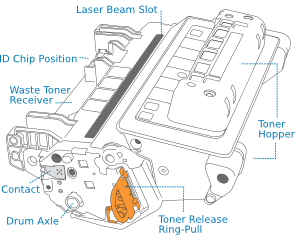
Cartridges for the LaserJet M604, M605 and M606 resemble their predecessors in the P4014 and M601 series. There is more here.
Consumables:
Mono laser printers have two main consumables - toner and paper.
One of the nice things about laser printers is that you can use bog standard office paper or "copier paper". Inkjets perform better with special paper but providing the paper meets the specification for a laser printer at all it will print quite well. A lot of the paper is now branded by printer companies, notably Xerox and HP. Paper can give problems if it isn't made and treated properly (more here). Unless something special is required paper isn't usually the main cost in printing.
Print Cartridges are where the action is.
Toner is a coloured powder that serves much the same purpose as ink. Laser printers use a combination of light from a laser and high voltage electrostatic fields to shape the toner into characters and images on the page.
Parts that wear out delivering toner are the photoconductor drum, developer, charge rollers, waste blade and doctor blade so these are wrapped up in a print-cartridge. These cartridges are an all-in-one design that replaces all the components vulnerable to wear and likely to cause poor print in one action.
The paper pickup rollers, transfer roller and fuser foils will also wear out and HP makes these available in a maintenance kit.
Print cartridges for the LaserJet M605 and M606 come in two types, both large by the standards of most colour printers - hence the low operating cost for these printers.
81A (CF281A) 10,500 page standard cartridge giving about 1p per page operating cost.
81X (CF281X) 25,000 page high yield cartridge giving about 0.7 p per page operating cost.
Compatible Cartridges
What some people will want to know is "when do the compatible cartridges arrive". Costs of 0.7p per page are good, but that cost can be cut to a third or less using remanufactured or compatible cartridges.
HP might hope "never" and will have worked on some cryptograms to stop smart-chip crackers Apex, Static Control, Datel and so forth devising replacement chips.
People who buy big printers intend to do a lot of printing, and the cost of the printer is trivial compared to the lifetime cost of cartridges.
Financing the print industry almost entirely through cartridge sales has become the standard model for the computer print industry.
Upside of cartridge based finance for the printer brands is that they can gain market share by shaving a few dollars from the printer price so it looks like a bargain. Then they more than recoup that investment by making cartridges rather expensive. Twenty or more cartridges are used during the life of a printer - and cartridges don't actually cost much to make.
Downsides are that competition between brands has driven the price of printers low but the price of cartridges very high - and that attracts both legitimate refillers and counterfeit fraud. The main protection the manufacturers have for their market share is the portfolio of copyright and patent claims and the smart chip.
What drives the printer industry is the need for manufacturers to stay one step ahead of re-manufacturers and smart-chip makers, rather than real technological advance. (A lot of industries have odd internal economics.)
Cartridge prices create a market for refilled and remanufactured cartridges. These don't (usually) infringe patents as nothing new is made, and they can be very much cheaper (we currently sell the P4015 cartridge CC364X for £153 and a remanufactured version for £38). These new CF281X cartridges can be found remanufactured online, but not currently from brands we know and respect. So for the moment HP are sole suppliers.
Many people choose to use HP originals for the whole life of a printer. Print quality and reliability are best assured.
There aren't many downsides to using remanufactured toner cartridges with a mono printer, particularly if you have onsite technical support. Cartridge related faults are usually recognisable and go away when a manufacturers original is used. Caveats are that bad toner might conceivably damage the fuser or transfer roller and the printer could need vacuuming out.
So if your print economics depend on really low prices, these printers will (almost certainly) deliver that - in a few months.
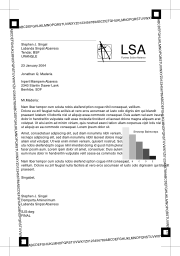
Cartridge Life
People are used to colour magazines and can find print cartridge life quite deceptive if they commonly print large pictures, logos, banners and the kind of form that has shades highlights and boxes. A bold banner at the top of a page can easily double the print area and half cartridge life.
Cartridge life is measured for pages with 5% cover according to an international standard ISO/IEC 19752 - used by almost all printer manufacturers. The test on which figures are based looks like a letter with a couple of small illustrations. The test runs continually on this single test page. This has the merit that it can be completed quite quickly and without too much argument. One noted disadvantage is that it can overstate the yield that will be achieved if you print lots of one-off single page documents.
The other noted disadvantage is that web pages and the look of a magazine give disappointingly low cartridge yields. At least the M604 series machines limit things to one colour! And the cartridges are pretty big.
LaserJet M604 printers do not accept the large 81X cartridges. Those are reserved for the M605 and M606 machines. It's a straight value proposition - you pay extra for the printer and you can use the bigger and more cost-effective cartridges.
These very large cartridges are expensive to buy - around £150 to £200 depending where you buy - which is more than the street-price of some entire printers. Cheap printers are designed to run at 2p-3p per page so they work out more expensive to run if you do a lot of printing. Big printers give the lowest cost per page and that is often the significant factor in the long term.
Deciding on Printer Model
How much print you intend to do decides whether you buy the M604 or one of the other models.
If you are buying one of these printers to get a highly reliable printer for a small office then the M604 has a lot to recommend it. A couple of people in an office might not use the 25,000 page capacity of the big cartridge in a year but might still want reliability. For corporates the M604 may also fit the printer "fleet" of larger machines.
LaserJet M604 is still a slightly strange beast, a big, reliable printer that doesn't take the largest cartridges. HP established this split between what models can do with the P4014 / P4015 in 2008. One print engine is made to serve several markets.
If you definitely will be running the printer as a "production machine" (or might) then that ability to take the big cartridges pays back surprisingly quickly - before you buy the third cartridge. The M605 and M606 then look a better bargain.
The deciding factor between the M605 and M606 is speed. For instance, if you print a monthly catalogue or price-list running to thousands of pages then that extra 7 pages per minute may be important and get the job done an hour faster. The same consideration would hold if you use one of these machines for picking and packing, is it worth having people wait an extra second or so?
People sometimes worry about the safety of toner. We do that below.
As well as the toners the printers also need maintenance kits from time to time - default setting is 225,000 pages. There is no difference between models, all take the same kit. Kits can be quite expensive, sometimes over £200, so that might seem a substantial cost. Actually its not a major burden - about 0.1p per page. To put it in perspective, 9 of the large cartridges at £150 or more each were just used - at a cost of £1350 or more. If you had bought a LaserJet P2055 (a popular office machine) the printer would only have cost £190 or so, but the 34 toner cartridges would have cost around £3,000. (There isn't an official maintenance kit for the P2055 although some Web vendors make them up - watch out though, the price is higher than buying a new P2035 and stripping it for the parts - and with a new printer you get a cartridge into the bargain.)
The only other regular requirement is that machines with the stapler-stacker will need the Q3216A HP Staple Cartridge Refill. The stapler stacker mechanism is also replaceable as a spare, it is said to have a life of 50,000 staples which may seem a lot but could be about one maintenance-kit worth of print.
You might wonder why smaller, cheaper printers aren't built like the M604 series (we do).
It's probably a combination of a need to keep costs down and frankly a lack of design attention. There is also a clear assumption that lesser printers and accessories will be replaced rather than repaired - an environmental tragedy.
Turning a fuser into a plug-in module does create extra costs of course, and it probably makes the printer a bit bigger.
Spares:
One of the features of the M604 series is that any significant part likely to need changing can easily be replaced, usually without carrying a screwdriver.
Rollers clip onto their shafts
The fuser plugs in at the back.
The list of spares include:
E6B67-67906 Tray 1 roller kit
E6B67-67905 Tray 2 through X roller kit
E6B67-67926 Torque Limiter kit
E6B67-67913 Replacement cassette for Tray 2
E6B67-67904 Transfer roller
HP has a pictorial instruction sheet with each kit. We give some instructions with pictures and words here.
Service engineers, site technicians and a printer's users generally like maintenance kits. There are a couple of big plus points.
In this case the maintenance kit is intended to be user installable. By all means try to get a service technician to do it, they may be more familiar with it - but it really is easy.
Once the kit is fitted all the normal sources of wear in the printer are gone - it is as good as new.
Because the kits are popular, shift in large numbers and are carried by several distributors they are often cheaper than a fuser on its own. We can't rewrite this on a daily basis to reflect that - but there may be prices alongside.
There is an element of waste in the maintenance kit. It is possible to wait for the fault then change the component. We don't know how many pages an E6B67-67902 fuser is capable of but suspect that ghosting and then foil failure might be in excess of 300,000 pages. This doesn't mean buying the parts individually (that would usually be poor logistics), just running them until the feed errors, poor transfer or fuser ghosting are spotted.
It takes knowledge of printers to spot problems as they occur and correct them. However some people run these machines as small printing presses and there will be a definite payback to running a fuser as long as possible.
Rollers use soft rubber to give a better grip on the paper but that does mean a limited life. These days HP seem a bit cautious about quoting a life-expectancy but back in the days of the LaserJet 4200 the service manual gave it as 200,000 pages. Roller wear depends on the nature of the material being fed. British tastes in office paper are rather different to those in the US or EU. Heavier media will probably impose more wear and so will stickier paper as the separation roller will fight more often. It also depends on tolerance of misfeeds, as roller condition declines from optimal so the probability of a misfeed rises.
The torque limiter reduces the power of the separation roller. We have rarely sold a torque limiter and notice that there are few on distributors stock lists and that stock levels stay constant. HP may have the statistics to justify changing them more often and making up a kit.
Incidentally these kits all seem to be the standard parts that actually date back to the LJ-4200. When something works, why change it?
HP has also listed some of the more commonly removed and lost/damaged covers:
RL2-1404-000CN Replacement Output accessory cover
RC4-5802-000CN Replacement Formatter cover
RM2-6310-000CN Replacement duplexer cover
RC4-5803-000CN Replacement HIP cover
RL1-1667-000CN Replacement Envelope feeder cover
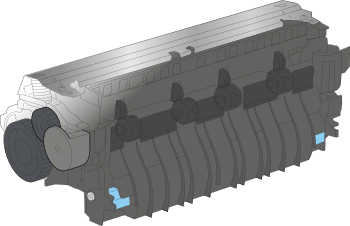
Maintenance Kits and Fusers
Outside the cartridge, the pickup rollers and fuser mechanism are the main parts subject to wear and with a limited life. HP provide a maintenance kit to replace these parts.
F2G76A HP Color LaserJet Printer 110V Maintenance Kit. US version.
F2G77A HP Color LaserJet Printer 220V Maintenance Kit. UK, Europe and rest of the world.
The maintenance kit should include a fuser, a transfer roller and at least one set of feed and separation rollers for the cassette tray - the ones with blue cores.
It is not always easy to state precisely what an HP maintenance kit will contain as they have changed the list without notice at times. For instance the CF065A kit for the M601 series doesn't include Tray 1 rollers (MP trays are not much used) or the white-cored pickup rollers.
Maintenance kits come with a set of instructions. (Or at least in the white box versions; there may be a brown-box engineering version that doesn't.)
Fusers are available on their own - it isn't unknown for a fuser to suffer a nasty accident with a staple or someone taking a knife to a stuck label.
E6B67-67901 Fuser kit (110 volt)
E6B67-67902 Fuser kit (220 volt)
It is very easy to change the fuser in the LaserJet M604 series - in fact taking it out is covered in the user guide as part of the procedure for removing a paper jam.
Options and Accessories:
The cartridge financed model of printing delivers cheap printers but it also messes up good office practices.
Take the stapler-stacker as an example. Printers like this are often used in offices to produce material that runs to longer than two sides. The pages are then stapled together. Stapling pages is simple enough for a human being - the work of a second if the pages are neatly stacked or more like five or ten seconds and running to minutes if some gonk has stolen the stapler again!
Since the 1970s big office copying machines have had a stapler; if the machine can do the task then it should. A stacker stapler is a moderately complex device because it has to jog the paper into a neat heap before putting the staple through the corner. Standalone electric staplers are not quite so complicated as the copier/printer version, but they sell for between £100 and £600.
HP introduced a stacker_stapler on the LaserJet 4200. They have produced a new model for each of their big laser printers ever since. But we have never seen them shipping in great numbers, either ourselves or through UK distribution.
The stapler stacker HP have produced for the M604 series printers is actually a rather nice gadget and a reasonable price for an electric stapler; it's a far more competent and interesting device than most. Many of the accessories such as the envelope feeder and the big 1500 sheet feeder don't seem to get the takeup they merit.
Part of that might be fear that they won't work properly. If you put an envelope feeder, a feeder cassette stack and a 5-bin mailbox on your printer will the cover letter, conveyancing document and envelope all go into the bin for the right person? If you use Microsoft word that is partly for Microsoft and partly for HP to answer (and our own online searches haven't yet answered whether its seamless).
Accessories meet user resistance caused by the odd pricing. Accessories often cost more than the printers, which is obviously incongruous and off-putting to potential buyers.
The problem is not that accessories are ridiculously expensive, they are actually quite cheap compared with other postroom equipment. The problem is that printers have been made somewhat cheap to get cartridge sales. But then when someone sees that they can have a printer for £350 and a stapler stacker for £450 its a laugh out loud moment - pay more for the stapler than for the printer? You have to be joking?
Time saving gadgets are ignored not because they cost too much but because the pricing doesn't compare favourably with printers. It isn't the accessories that are expensive, it's the printers being rather oddly cheap.
How Useful Are Accessories?
As we suggested, if most documents get stapled then what is more logical than that the printer should do it?
If most of what you do goes in an envelope then an envelope feeder will speed things up. If you are not usually hard-pressed then the benefit might not be great in overall productivity, but in being able to process a few more orders before the post goes at times of pressure. The same work gets done, some people get things a bit quicker.
The 5 bin mailbox means your documents don't get mixed with your co-workers - at least until there are more than six of you sharing a machine. Since the printer seems aimed at workgroups of ten it is a pity there isn't a ten bin mailbox - perhaps it would be too impressively big and weird?
Some printers work to mainly produce orders and despatch notes. The best form of process automation would be to stop printing and store the documents as PDFs. (We print incoming orders and packing slips and despatch notes, but we don't print outgoing orders and only keep a PDF of acknowledgements with one supplier who sometimes denies receiving orders placed via their website).
Other printers produce a stream of documents and they ought to be the heart of a system designed for the job, pulling letterhead, plain paper, coloured paper and envelopes from trays as needed and assembling the final item. The ideal is a book production machine (they do exist, but HP don't have an accessory to do it).
Safety:
Laser printers are not noted safety hazards but giving some thought to the issue is one of those points of due diligence that modern businesses strive to include. Sometimes it may slow decision-making, but things may also end up being done better.
The most impressive thing about laser printers is the name. Actually the laser is similar to those in CD-rewriters - powerful enough to change a susceptible material. The only part of a human susceptible to damage is the eye; to stop anyone looking into it there is a shield and a cutout. (You would have to fit you head where the cartridge goes and assume a lumbar dance position to expose your eyes.)
The main thrust of how the printer works is manipulation of a fine toner dust by electrostatic fields - the formal name for the technology is "electrophotography". The electrostatic fields are created partly by high voltage circuits which could deliver a fatal shock and partly by triboelectric charging (charging through rubbing) which would not. The printer is also connected to mains (line) power. The laser and high voltage circuits are protected by the cutout, making the printer no more dangerous than any other mains powered device.
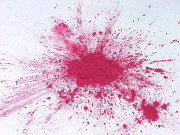
Toner
The chemical safety of toner is probably the main safety concern.
Print brands promote their toner as scientific works whose exact formulation is critical (like Coca Cola, with fewer imitators). Colourants and inks are indeed a complex area. The foundation of modern chemistry was William Henry Perkin's discovery that mauve dye can be extracted from coal tar. BASF (Baden Aniline and Soda Factory) built the gasworks in Baden, and then became more interested in the chemistry of the dyes and drugs that could be produced. BASF became the biggest chemical company. Chester Carlson's invention of electrophotography in the 1930s led to Xerox becoming one of the biggest office equipment companies in the 1960s. Fortunes ride on print.
Mono print toner isn't all that special. It is usually a finely granulated plastic carrier with a trace of carbon black. The technology is changing; older and crude toners are made by grinding, but that produces large and uneven grains. Growing the material in solution, gives smooth grains about 5 microns in diameter allowing fine resolution print. Toners can have a hard shell that resists damage surrounding a soft and easily melted core. A dozen or so companies worldwide produce toner and typically either produce cartridges themselves (as Canon do in their Virginia plant), other companies sell it in batches or even in 10 kilo bags.
The Material Safety Data Sheet (MSDS) is intended to provide workers and emergency workers with information and procedures for working with a substance in a safe manner. Getting the manufacturers MSDS is easy online:
For instance to get the CF281A
try a Google, Bing or any search for
CF281A "MSDS" inurl:hp.com
Print brands publish a Material Safety Data Sheet for each toner. That for the CF281A cartridge suggests it is a fairly typical HP/Canon single-part magnetic toner made primarily of polyester resin (<55%) and iron oxide (<50%), with a small amount of amorphous fumed silica. The specific polyester is "trade secret" - there are several hundred types and it is probably a mixture. Iron oxide helps the developer deliver a smooth layer. The amorphous silica is used partly for flow and partly as a "charge agent" to control the toner's static electric charge.
HP have left the colourant out of the list. Black toner is almost always carbon black in a quantity around 1% and low quantities don't have to be declared on an MSDS. There is no mention of a lubricant for fuser separation either, although there probably is one. There are probably other charge agents present in small quantities.
Some printers create aerosols - tiny airborne particles of carrier and colour. Evidence that the HP M604 series create aerosols is scant. What we can say is that opening up P4014 and M601 series printers there is usually a dust accumulation on the vent and that is the fawn colour of ordinary dust, not the black of toner. That might be different with some remanufactured cartridges of course.
People worry about the composition of toner, seeking out corporate wickedness. They probably need to lighten up by going to a festival of colours. However we suggest treating toner with respect but not alarm and we have a page on cleaning up printers and spills here. Basic recommendations are to avoid the temptation to use an ordinary vacuum cleaner as toner particles can pass through the bag, to tap rather than brush toner off things so far as possible, perhaps into an old envelope. Use cold water and soap where necessary.
Printer Stands
HPs accessories like the printer stand and feeders mean the printer can be free standing. If there are airborne particles around a printer the numbers will be proportionate to how much it works and then to how much the air has been diluted. You probably don't want a printer like the M604dn on your desk anyway, it is quite a big beast.
However a stack of feeder trays is an expensive way to lift a printer off the floor. One solution is just to use any old side table. Be a bit cautious here. We haven't seen a problem with the LaserJet M604 or it's predecessors but printers are quite heavy and veneered chipboard that seems adequate as a desk distorts easily. We have seen several instances of colour printers misbehaving on a desk but not on the floor - the sag in the desk distorted the chassis. A Dataflex
heavy duty printer stand might be the sort of thing to look for, they cost about £280.
Copyright G & J Huskinson & MindMachine Associates Ltd 2013, 2015. Some pictures derived from HP stock shots, User and Service guides, others are our own copyright. These technical pages do not constitute an offer for sale; just our knowledge at the time of writing. See the catalogue. Sales pages on this Web site use cookies to store user information. We also use Google Analytics to track site usage patterns.

